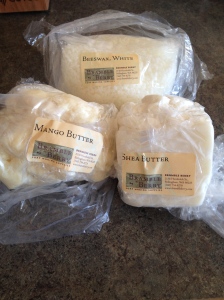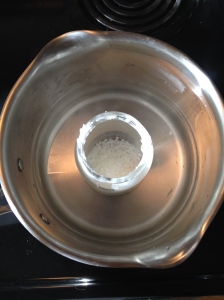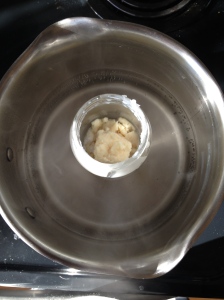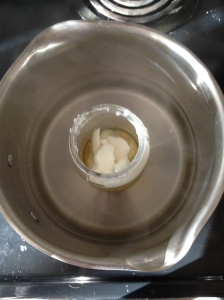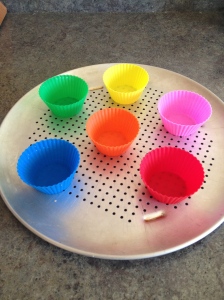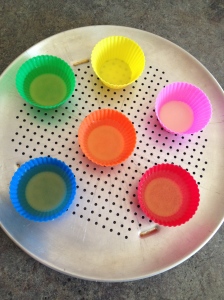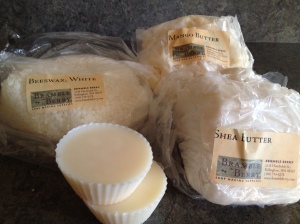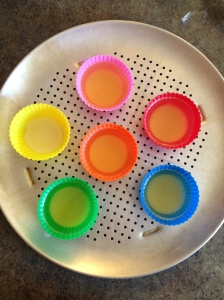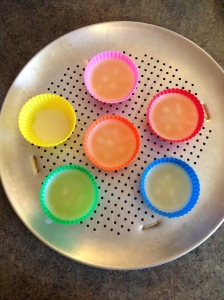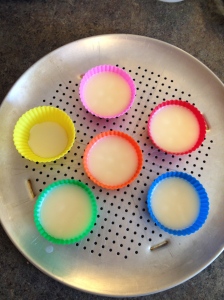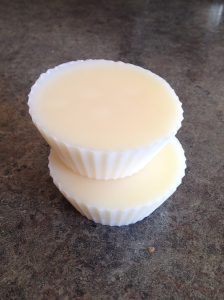First off, I did not get ample photos of my (mis)adventures for the first several batches. Future posts will have more eye candy.
I knew my first attempt at making shampoo bars would be tricky, and I was right. Mainly because I can be scatter-brained and my mind goes a thousand miles an hour sometimes. While my mind was going at warp speed, I used 6 oz of castor oil instead of 8 oz. D’oh! Here’s the story….
I’ve used this 3lb shampoo bar recipe (ingredients at the end of this post) countless times with my friend in Idaho, so I was almost too confident when I was measuring out the ingredients. Combine this with the nervousness of making cold process soap for the first time by yourself and you have a recipe for sub-par soap. And, yes, it is possible to be too confident and extremely nervous at the same time. I was too confident because I knew we’d made this awesome recipe tons of times. I was extremely nervous because I realized that a lot goes into properly making soap and my friend was usually the brains of the operation. I was missing the brains!
The overall first attempt went relatively well, even with the batter accelerating quickly due to the type of fragrance oil used. Several hours after pouring the batter in to plastic molds that I got from Michael’s (more on these molds later), my mind kept telling me that I didn’t use enough castor oil. I measured the remaining castor oil that I had on the shelf and, grrr, I had more than I should have. Rebatch time! (and more lessons to be learned!)
After Googling how to rebatch, I put my half solid shampoo bars, 2 oz of castor oil, and about 2 oz of milk into a Crockpot and set it on high. I don’t know if the milk was necessary, as the bars were still semi-soft. I mixed the goo about every thirty minutes and decided everything was done after about 3 and a half hours of cooking. My mixture looked just like the pictures I found on other peoples’ blogs, so I figured I was okay. I plopped the gel-like goo back into my cheap, plastic molds again, tapped the molds on the counter to get rid of air bubbles, crossed my fingers, and finally went to bed. It was about 11:30pm.
I woke up the next morning to solidified shampoo bars! I was ecstatic beyond belief because, though the shampoo bars sort of looked like muscles (or vomit), I was pretty sure I had a usable product after my measuring mishap. The only things I wish I would have done was 1.) use sodium lactate in my mixture, which helps to solidify the bars quicker, and 2.) use silicone molds. Since I used milk in the rebatch, the bars are taking longer to harden. Since I’m using plastic molds (never again!), I cannot get the bars out. Basically, I have to let them fully cure and harden in the molds. I check them each day and they seem to be slowly loosening from the plastic. (and I’m slowly dying inside waiting for this to happen)
Since I technically turned the cold process shampoo into hot process shampoo during rebatch, I sped up the saponification process and the bars can be used as soon as they pop out of the molds. Yesterday, I tested one of the free bars and it worked just fine (slow clap). My absent-mindedness was overcome! Overall, lessons were learned and I made a usable product. It just sort of looks… weird.
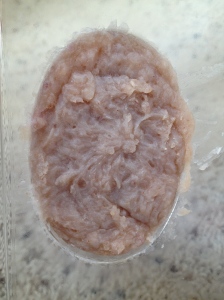
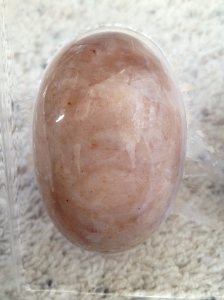
Oh well. I’m sure my friends and family will be happy to get a free bar or two.
And that’s my first attempt at solo soap making. It can only go up from here (hint: it doesn’t. Read my next post.).
3 lb cold process shampoo bar recipe:
10 oz coconut oil
10 oz palm oil
8 oz castor oil
8 oz olive oil
12 oz distilled water
5 oz sodium hydroxide (lye)
**disclaimer: please use the necessary safety precautions when making soap and working with lye. There are many helpful tutorials on the web that discuss the precautions one should take while working with caustic chemicals.
Holly
